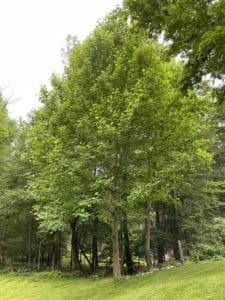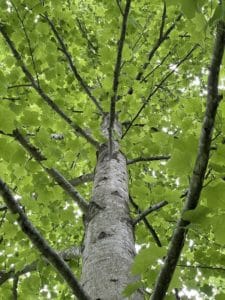Hello fellow readers, On Friday, while walking Jolee, I came upon a flower of a Tuliptree attached to a cluster of leaves. I learned about the culprit —squirrels building nests or sharpening their teeth, which became a column about the Litter of Tree Tips we see along roads and walks each spring. Mother Nature’s way of pruning (smile). Relishing the flower inspires a story of two treasured Tuliptrees I hope you’ll enjoy.
Why we rarely see Tuliptree flowers up close

We rarely see Tuliptree flowers up close and personal

Tuliptrees get their name from their tulip-shaped leaves and flowers
We rarely see Tuliptree flowers up close and personal in their glory in late May or June as they tend to be high on the tree. We usually only see the petals of the flowers when they drop. Plus, baby trees take six to ten years to bloom. So, the squirrel’s castaway was a treasure to hold.
A momma Tuliptree, thirty feet away from the screen porch, sprouted a baby tree where a Blue Spruce once lived. When we moved to the property, I adored Mr. Blue just outside the porch. But as the years unfolded, he began dying from the bottom up as stands of them have for the last few years caused by needle cast or canker disease. Fast forward a few years, the sad day came to cut Mr. Blue down.
I first kept the treasured baby Tuliptree to myself.
Then came the baby Tuliptree — a volunteer sapling almost in the same spot. I kept the treasure to myself, knowing the vigor and speed of its growth. Knowing that Curt would say it’s too close to the house.
Tuliptrees (Liriodendron tulipifera) get their name from their tulip-shaped leaves and flowers. They grow to 70 to 90 feet with a 30 to 50-foot spread at maturity. Some grow to 150 to 190 feet—making them one of the tallest native eastern American trees. Also known as Tulip Poplar, Yellow Poplar, or Tulip Magnolia, they grow about fifteen to twenty feet in six to eight years. It won’t take long before the baby stands as tall as its mother, about forty feet.
Tuliptree’s sought-after hardwood is known as poplar

Standing below the Momma tree feels sacred.

Then came the Baby Tuliptree — a volunteer sapling…
Despite being fast growers, they are hardwood trees. The fine-grained wood is known as poplar in the trades, short for Yellow Poplar, and is often used for furniture and carpentry in homes. A bit of history—George Washington planted Tuliptrees at Mount Vernon, now standing 140 feet tall. And Daniel Boone used a Tuliptree for a sixty-foot dugout canoe.
One day my baby was found. Curt claimed we should move it before it gets too large. But I admire it from my writing spot on the screen porch; its glorious hand-sized lime green leaves are a beautiful contrast to the hemlock behind it, and I adore how the leaves unfold like a flag and turn golden yellow in fall.
Walking below our Momma Tuliptree feels sacred.
Tuliptree trunks are strikingly straight, and the momma tree has a commanding canopy, making standing below her feel sacred. In the winter, the dry remains of the flowers look like little cups reaching for the sky. They prefer Full Sun, though ours are thriving in half shade. And they are adaptable to clay, sandy, or loamy soil, preferably acidic.
Hummingbirds feed on the nectar, and other birds feed on the persistent seeds in winter. Deer will browse young trees in fall and winter, but branches quickly grow out of reach.

Tuliptree trunks are strikingly straight.
Two years ago, Curt took it upon himself to prune the top leader, “by accident,” he explained, reminding me we need to move the tree. “We will come fall,” I say, adding, “When the tree is dormant is a better time.” But leaf removal always takes precedence, and my baby tree remains. Yay.
I felt sad for the baby tree with the disfiguring haircut. Topping a tree is never a good idea putting tremendous stress and weakening the tree. Gratefully as the season unfolded, new shoots filled in, and one has taken the lead.
Now the tree will be challenging to move, about two-inch caliper and twenty feet tall, but still doable. I’m keeping my mouth mum, though. There’s something magical about a seed finding its way to a perfect spot filling the void of an adored tree that served its time.
Garden Dilemmas? AskMaryStone@gmail.com (and on your favorite Podcast App.)
An Addendum
Would I have planted a tulip tree where the blue spruce once stood? Likely not because of the size it will become. However, I will not change what nature decided to plant. Instead, I marvel at the miracle.

Austin & Sammi Stone
Besides, it’s a hardwood tree with a trunk that grows so straight that I don’t worry that it will fall on the house. Just let it be healthy and stand tall — trees are resilient, and so are we. If I may share an update on my nephew’s wife, Sammi: She is out of the hospital and has begun chemotherapy treatments. On behalf of my family, thank you, kind readers, for your prayers.
As written in Verse 64 of the Tao Te Ching over 2500 years ago, “A tree that fills a man’s embrace grows from a seedling. A tower nine stories high starts with one brick. A journey of a thousand miles begins with a single step.”
You’ll enjoy listening to more about this story in the Garden Dilemmas Podcast:
More about the benefits of Tuliptrees on the Arbor Day Foundation website
Links to related columns Litter of Tree Tips and Spruce Disease Dilemmas


